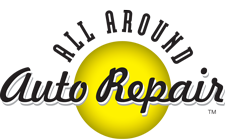You might have been told to hit the brakes and stop in for routine maintenance before…but what if your brakes aren’t working as well as they should be. Well, for starters, a brake inspection should always be a part of your routine maintenance.
A brake inspection essentially gives you a report card on how well a number of parts are performing. Your entire brake system will be checked during an inspection, and this will include brake lines, brake hoses, and brake assemblies. Your brake assembly includes your drum brakes and disc brakes.
Brake Inspection 101: The Pedal

Importantly, your brake inspection will also entail an inspection of your brake fluid and making sure that your brake pedal is working optimally. It’s surprising how many things can be slightly off with your brake pedal. The pedal, after all, is how you communicate with your entire braking system, so that needs to be working perfectly.
Pedal Height
The experienced, certified auto mechanics at All Around Auto Repair will check that your brake pedal’s height is optimal before ensuring that there’s not too much free play and that your brake pedal’s reserve distance is just right. How can you tell, though, when something like that is just right?
The answer: Your manufacturer’s specifications as outlined in the owner’s manual! Your pedal’s height is laid out in the owner’s manual, and it should basically be a particular distance to the floor of your vehicle when the brake pedal is not engaged.
Free Play
So, what about free play and your brake pedal’s reserve distance? Well, free play refers to the distance between your brake height (when the pedal is at rest) to the point at which your pedal engages your braking system.
Too little distance makes your brakes so responsive that the slightest touch will engage the system and too much distance between the pedal height and engaging the brakes could make your brakes too slow to respond. That could be dangerous in a situation in which you need your brakes to engage immediately.
During a brake inspection, the mechanics at All Around Auto Repair might find that your vehicle’s brakes have too much free play, which could indicate an issue with the return springs on your braking system or pedal bushings that aren’t quite right.
Reserve Distance
You may have already guessed what your pedal’s reserve distance refers to based on the pedal height and free play. Reserve distance is the distance between the pedal and the floor when the brakes are fully engaged.
Your cylinder’s pushrod could be a factor in the numbers being off with your reserve distance. This is all set by your owner’s manual and checked during a brake inspection, so there’s no need to worry.
Warning Signs to Heed Right Away
Your brakes usually give off a number of warning signs before they fail or become inoperative. If your pedal seems to sink towards the floor, for instance, that would indicate issues with your free play and reserve distance (see above) and could signal a leak in your vehicle’s braking system or air leak in your vehicle’s brake hose.
Most people actually diagnose the grinding sound correctly – that means that your brake pads are probably totally shot and need replacing. A vibration, on the other hand, might mean that your rotors are telling you that your vehicle is out of sync and needs an alignment.
Come in to All Around Auto Repair to have all of these systems checked in a thorough brake inspection. Get your brake height, free play, and reserve distance checked and fluid changed today! Contact us for more information.

